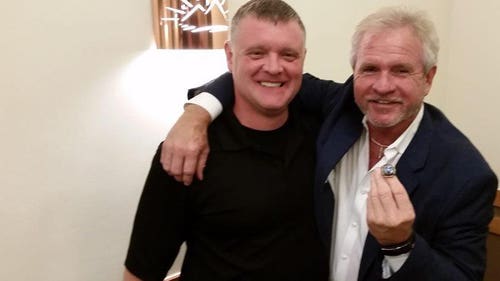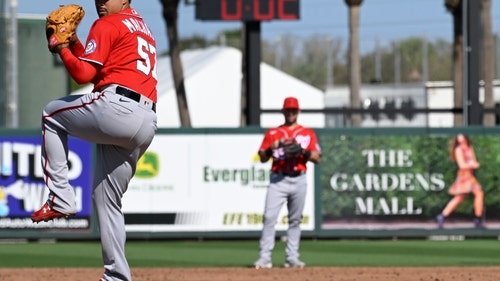
Once of the verge of extinction, Dodgertown makes a comeback

VERO BEACH, Fla. (AP) The ghosts of Dodgertown are everywhere.
Along the narrow roads winding through the complex, named after Jackie Robinson, Pee Wee Reese and other Dodger greats. On the deck of the swimming pool, where the players relaxed and bonded once their work was done each day. At the tiny bridge they crossed for each spring training game, strolling right among the fans as they made their way from the clubhouse to Holman Stadium.
Now, a new generation is getting to discover this baseball gem.
''It's like walking on hallowed ground,'' said Reid Wilkinson, a senior at Norfolk Collegiate School in Virginia, a private high school which is training and playing games at Dodgertown this week.
The longtime spring training home of the Dodgers - starting in 1948 when they were still in Brooklyn, and continuing on after they moved to Los Angeles - was threatened with extinction after its namesake team moved its preseason operations to Arizona in 2008.
But, thanks largely to former Dodgers owner Peter O'Malley, the sprawling complex located on a former World War II military base has made quite a comeback, serving as a training hub for hundreds of college and high school teams, as well as international squads and even the Canadian Football League.
Working with his sister Theresa, O'Malley was determined to keep Dodgertown alive.
''It gives me pleasure and enjoyment,'' O'Malley told The Associated Press in a phone interview Thursday, ''to know we're doing something significant now and for the future.''
The place just oozes history. Holman Stadium, known for its barren dugouts (still covered by only a tarp) and palm trees just beyond the outfield wall (which used to be in play), remains the centerpiece of the complex. The sliding pits and batting cages and pitching area known as ''The Strings'' - a Branch Rickey creation, where up to six pitchers could warm up simultaneously and strings were held on poles in front of the catcher to simulate the strike zone - are still here. So are the 1970s-era villas and dining hall, where the Dodgers once slept and ate, as well as the pool and the tennis courts.
''It was heaven,'' said former Atlanta Braves manager Bobby Cox, who began his playing career with the Dodgers in 1960. ''They had this cafeteria. The major leaguers ate there. The minor leaguers ate there. One day, you might be having breakfast or lunch with Duke Snider or (Sandy) Koufax or just about anybody. I remember Mr. (Walter) O'Malley (the longtime owner of the Dodgers and Peter's father), he would eat in there. I remember him vividly. It was really close knit. You became an organization, with the loyalty and the friendship.''
Indeed, Dodgertown was the forerunner of the elaborate spring training complexes of today, with the stadium and back fields and training facilities all located in close proximity. But unlike the modern complexes, the players didn't scatter to their fancy condos and luxury hotel rooms at the end of each day. Everyone stayed right at Dodgertown, using old naval barracks in the early days.
''You used to stay four and six to a room, with a common bathroom,'' Cox said. ''It was the greatest thing.''
O'Malley remembers that camaraderie being the centerpiece of a philosophy known as ''The Dodger Way,'' which helped build the close-knit teams that would go on to win six World Series championships.
''We called it our secret weapon,'' he said. ''We brought everybody together, from the scouts to the minor league managers, everybody. Everybody got a chance to cross paths. It felt like a college campus. There was no other facility like that.''
That's why O'Malley felt It was so important to save Dodgertown.
After the major league team left for the Arizona desert, the facility sat vacant for more than a year. There was an attempt to lure in the Baltimore Orioles as replacement, but nothing came of it. Minor league baseball began using the complex in 2009, focusing on projects such as umpire training, only to abandon that money-losing venture after only three years. Making matters worse, the facility couldn't even keep its name - that belonged to the Dodgers, so it became the Vero Beach Sports Village.
That wasn't much of a selling point when the facility tried to lure in new clients.
''Nobody knew what the Vero Speech Sports Village was,'' said Jeff Biddle, the vice president of sales and marketing.
At that point, it looked like Dodgertown was doomed. But O'Malley, whose father was vilified for moving the Dodgers from Brooklyn to Los Angeles after the 1957 season, stepped in to preserve another treasured piece of baseball history.
''It was about to be shuttered for the second time,'' he said. ''I told my sister, `If it's shuttered for the second time, it's over. It will become light industry for the airport (next week).' It has too much history and is too unique to let that happen.''
O'Malley took over the complex in 2013 and, with financial assistance from the local government, set out to restore Dodgertown to its former glory. First, he worked out a deal with the Dodgers and Major League Baseball to restore the name. A lake was filled in, providing room for four new softball and youth baseball fields. A half diamond once used by the Dodgers was converted into a multi-purpose field, capable of hosting football, soccer and lacrosse. Lights were installed on the outer fields, giving the complex much more flexibility for luring in business. .
This year, more than 200 high school and college teams from the North and Midwest are booked into Dodgertown, reveling at the chance to escape their cold-weather climates and recapture a little of the magic the Dodgers once had.
''I love it,'' said Donovan Waefler, head coach of Norfolk Collegiate School. ''Just the team unity, the whole baseball atmosphere. It's a blessing to come down here and get out of the 40-degree weather.''
Meanwhile, long-time baseball fans still pop in when they see the famous ''Historic Dodgertown, Est. 1948'' signs along the road. Many of the hallways and rooms are de facto museums, adorned with pictures and memorabilia donated by the O'Malley family.
''This is phenomenal,'' said Jonathan Angell, wondering a hallway with his wife, Karen, who attended a game at Brooklyn's Ebbetts Field when she was a young child. ''It brings back so many memories.''
Then they headed off to watch a college game at Holman Stadium, reveling in the chance to create some new memories.
---
Follow Paul Newberry on Twitter at www.twitter.com/pnewberry1963 . His work can be found at http://bigstory.ap.org/content/paul-newberry .










